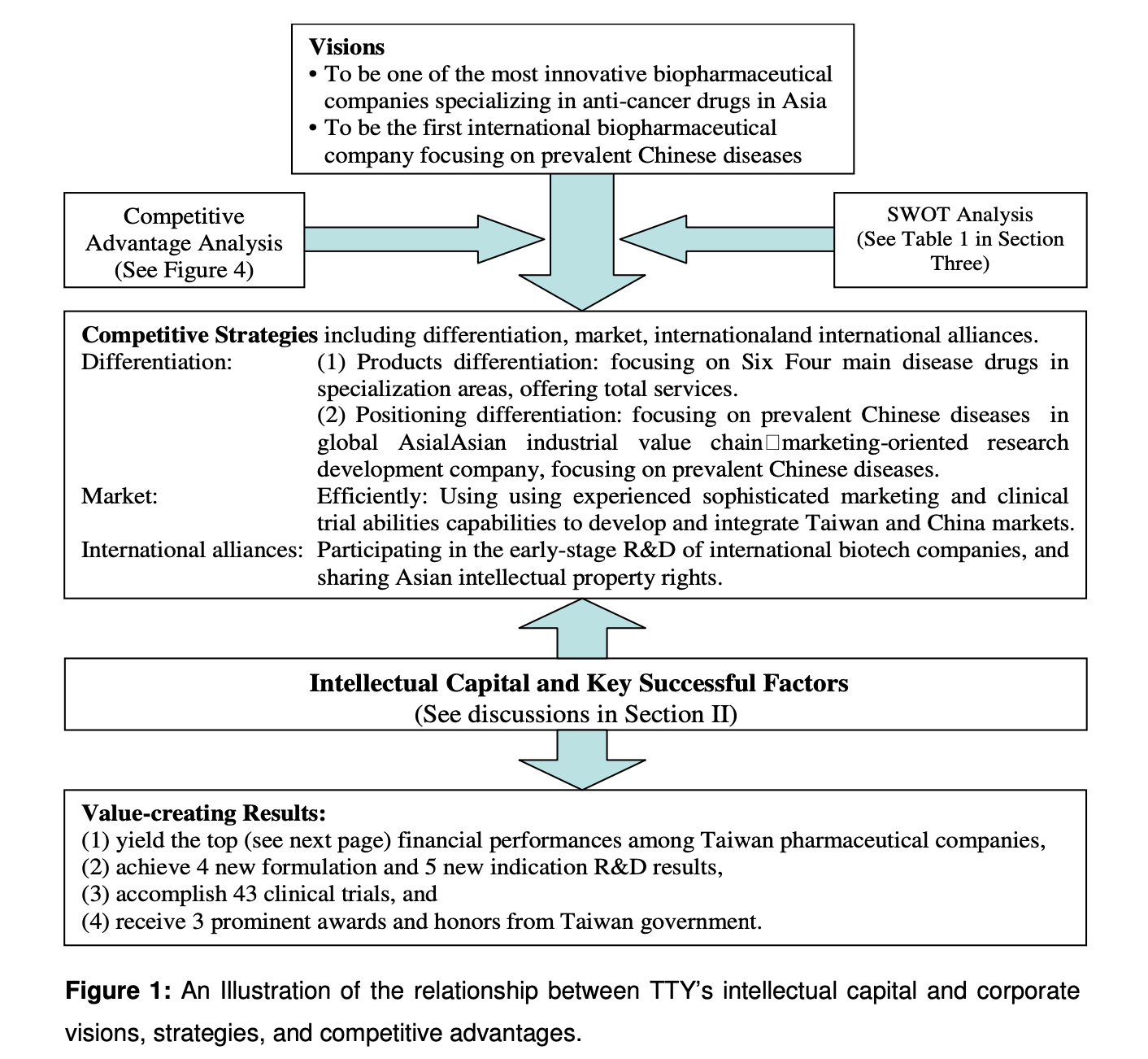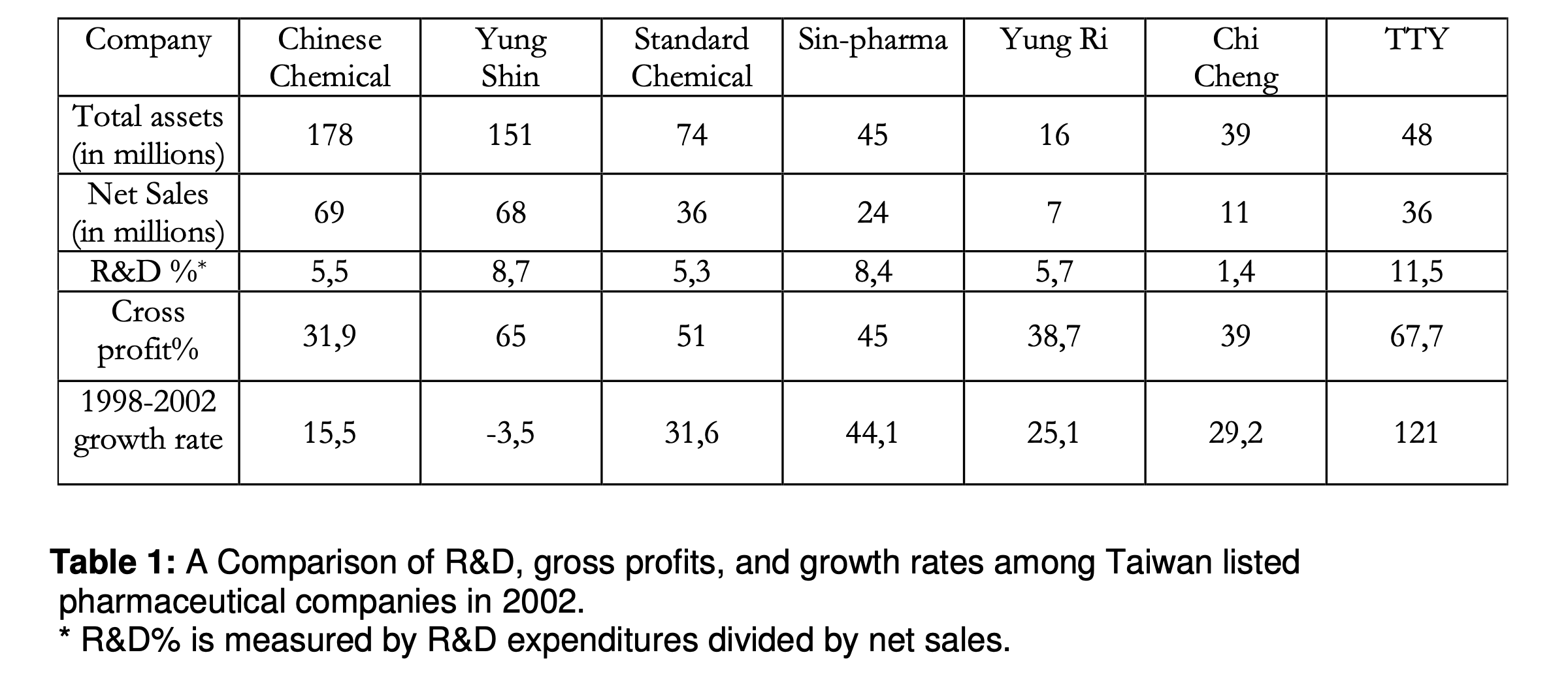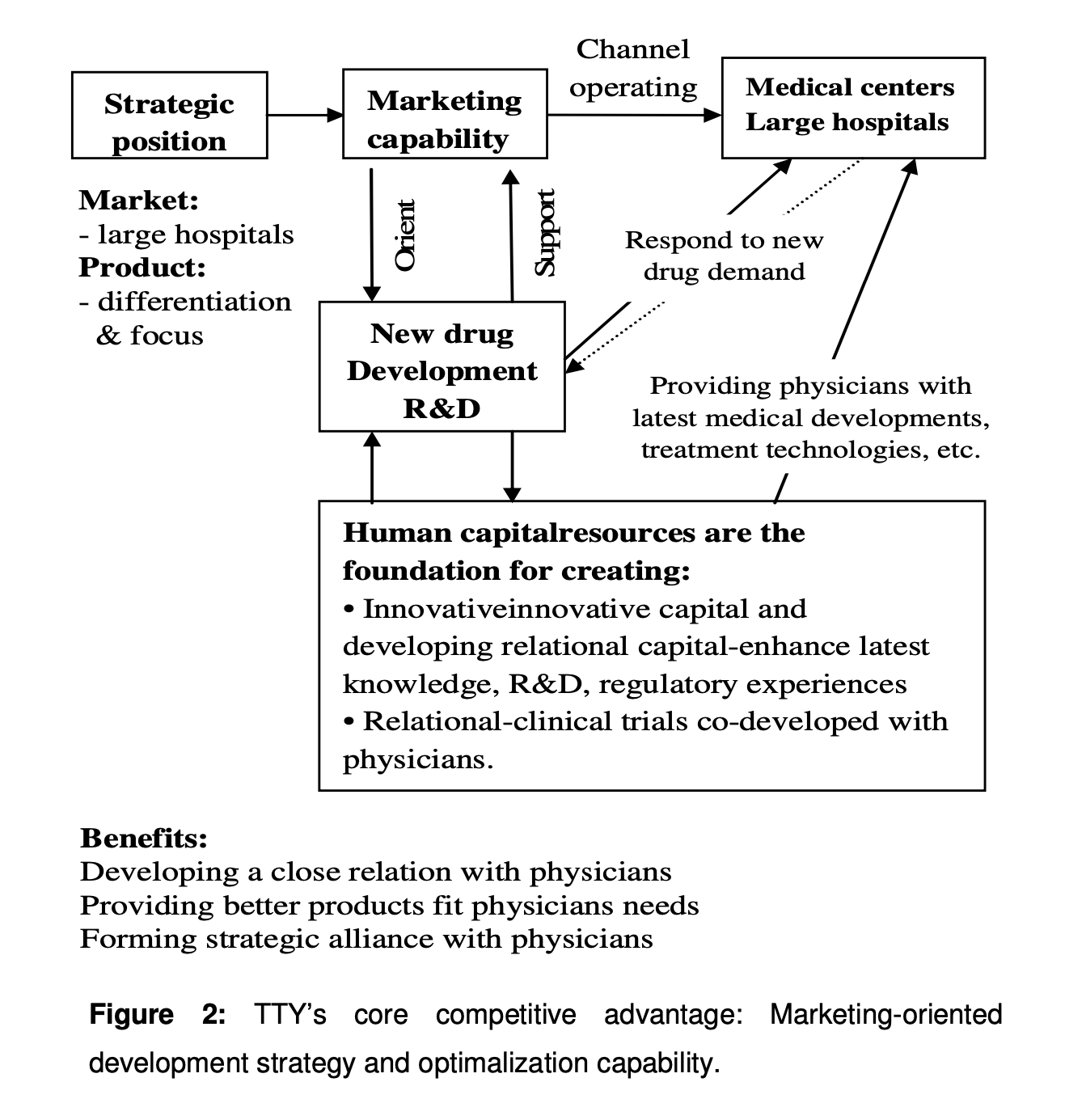Intellectual capital and competitive advantages: the case of TTY Biopharm Company
Abstract
By conducting indepth interviews with the CEO and top management of TTY Biopharm Company, a Taiwan-based pharmaceutical company, I depict the role of TTY’s intellectual capital in building competitive advantages and enhancing the achievement of corporate strategies. TTY’s success illustrates that even in a relatively small pharmaceutical market such as Taiwan, where a full-range new drug R&D, covering from discovering new chemicals to developing new drugs, seems economically infeasible, adopting fit R&D strategies and developing intellectual capital to establish competitive advantages can overcome the limitations in home market size and bear fruitful results.
Introduction
Intellectual capital includes human capital and structural capital wrapped up in customers, processes, databases, brands, and systems (Edvinsson and Malone 1997),(1) and has been playing an increasingly important role in creating corporate wealth and growth (Lev and Zarowin 1999).(2) The growing divergence between firms’ market value and book value shows that much of the source of economic value is no longer the production of material goods, but the creation of intellectual capital (Goldfinger 1997). Cañibano et al. (2000) summarized an extensive body of empirical evidence on the value relevance of investments in intellectual capital such as R&D, advertising, patents, brands and trademarks, customer satisfaction, human resources.
Pharmaceutical industry is heavily characterized as one of the most innovative, knowledge-based, and R&D-intensive industries. The innovation in the industry has been in a large measure driven by the persistent and successful pharmaceutical R&D effort (Aboody and Lev 2001).(3) As innovation becomes key to success in the pharmaceutical industry, pharmaceutical companies usually needs vast investment in a new drug R&D and takes lengthy processes to launch a new drug to the market. Consequently, it demands a sizable product market to support the mega R&D costs.
Given the small home market size,(4) pharmaceutical companies in Taiwan may not afford the vast costs of a whole-range new drug R&D, covering from discovering new chemicals to developing new drugs. Therefore, most pharmaceutical companies in Taiwan are essentially generic drug manufacturers. The competition for this type companies mainly focuses on low costs and low prices.
Established in 1960, TTY Biopharm Company (hereafter, TTY) used to be a traditional, generic drug pharmaceutical company that focused on production and sales. Due to the keen price- cutting competition and deteriorating in generic product margins, TTY was once close to being bankrupt. However, in 1996 a new management team came in TTY and started reforming and repositioning the company. It initiated the strategy of branding generic drugs to differentiate from other generic manufacturers. To carry out this strategy, TTY began to build up new drug development capabilities to enhance product brand and quality. The approach achieved great success in increasing sales margins and promoting the company’s image, helping TTY to leave out the endless price-cutting competition in the generic drug market and, thus, can channel more cash into long-term new drug development. The transition runs fairly well. In 2001, the company successfully launched IPO in Taiwan OTC technology listings and its registered capital increased triply from (US) $4.29 million5 in 1997 to $14.29 million in 2003.(6)
Using the case study methods, this paper is to investigate TTY’s intellectual capital and depict the role of TTY’s intellectual capital in enhancing its key successful factors to achieve corporate strategies. In their conceptual intellectual capital model, Roos et al. (1998, p.63) also emphasized that in cultivating and managing intellectual capital, selected measures for intellectual capital should link to firms’ key successful factors derived from corporate strategies. Therefore, this study is expected to have contribution to illustrating Roos et al.’s conceptual model by analyzing the case company’s transformation and intellectual capital management.
TTY’s intellectual capital and competitive advantages
Figure 1 depicts the role of TTY’s intellectual capital in supporting the achievement of corporate visions, strategies, and competitive advantages. Having successfully transformed from a traditional generic manufacturer into a new drug development company, TTY’s vision now is seeking to be an innovative biopharmaceutical company specializing in anti-cancer drugs in Asia and focusing on new drugs for prevalent Chinese diseases.

In light of the increasing competition in pharmaceutical industry, TTY identifies five key successful factors (KSFs), including (1) bring corporate strategies into operation, (2) recruiting and training right people, (3) effective manage- ment of pipeline and portfolio, (4) becoming a preferred partner for strategic alliances, and (5) reducing time to reach the highest sales. TTY’s intellectual capital plays an important role in enhancing those key successful factors.
The first KSF is related to the execution of corporate strategies. TTY positions itself as a marketing-oriented, new drug development company. In order to demand high prices for its branded new drugs, TTY focuses its major relational capital on large hospitals.(7) In developing innovative capital, TTY’s R&D strategy is not to conduct a whole-range new drug R&D. Instead, it focuses on the phase III new drug development, which includes developing new indication and new formulation drugs. Consistent with the company’s self-positioning, the phase III development is the closet stage to the product market; therefore, focusing on this stage can limit TTY’s R&D risks and expedite the payback periods. Table 1 compares TTY’s R&D intensity, gross margins, and growth rates with other pharmaceutical companies listed in Taiwan stock market. Although TTY invested in the highest R&D intensity, it remains to be the most profitable and fast growing company.(8)

In supporting of the KSF of recruiting and maintaining quality work force, TTY stresses on investment in human resources. Its average employee training and education costs are one of the highest among Taiwan’s listed companies. The payoff for TTY’s investment in human capital is quite fruitful. The company’s average employee productivity increased from $108,000 in 2000 to $148,200 in 2002.(9)
To reduce time to reach the highest sales, TTY’s strategy is to invite its major customers to participate in the early stage of new drug R&D, thereby developing products better fit customers’ needs. Co-developing new drug with physicians not only expands the company’s innovative capital, but enhances relational capital with major customers as well. Figure 2 summarizes TTY’s optimalization capability of the marketing-oriented development strategy in building its core competitive edges. Based on its strategic position, TTY devotes substantial resources to building solid distribution channels with large hospitals and medical centers.(10)

Physicians of large hospitals and medical centers are more willing to use new treatments and new drugs for patients. Feedbacks from them often provide the direction for future new drug development. Finally, TTY’s innovative capital and relational capital also bring the advantages in seeking international strategic alliances. By establishing expertise and clinical experiences in prevalent Chinese diseases as well as distribution channels in Chinese drug market, TTY is well equipped as a preferred partner for international pharmaceutical giants seeking to enter the Chinese market.
Value-creating Results
TTY’s successful transformation brings fruitful results in both financial and nonfinancial performances. TTY’s financial performances yielded leaped growth, with sales growing from $22.6 million in 2000 to $35.6 million in 2002 and EPS growing from $0.05 in 2000 to $0.17 in 2002, on a retrospective basis.(11)
TTY’s financial performances come from its advancements in R&D results. It is the first company in Taiwan and the third in the world to launch the liposomal (nanotechnology) formulations. In addition, the company’s new indication development has successfully launched several anti-cancer drugs in both Taiwan and overseas markets. During 2001-2003, TTY received three prominent awards and honors from Taiwan government in recognition of its technological innovation and achievements in the pharmaceutical industry.
Conclusions and discussions
Given Taiwan’s small pharmaceutical market size, it seems economically infeasible to support the whole phases of a new drug R&D, covering from discovering new chemicals to developing new drugs. However, TTY’s success illustrates that even in a relatively small home market size, adopting adequate R&D strategies and investing in intellectual capital can bear fruitful results. By developing intellectual capital, the company is able to maintain quality workforce, enhance relations with stakeholders, fulfill fit R&D strategies, and establish a supportive organization.
Despite recognizing the importance of intellectual capital and considerably investing in it, TTY, like many other companies, still has not developed appropriate measures for intellectual capital. As executives and employees paid attention to what they measured and could not manage well what they were not measuring (Kaplan and Norton 2004, p.6), the lack of measures makes TTY difficult to objectively evaluate and monitor the changes in intellectual capital. Further, Kaplan and Norton (2004, p.13) indicate that the value of intangible assets derives from their ability to help the organization implement its strategy. Therefore, the value of intellectual capital depends on how it helps achieve corporate strategies.(12) In developing intellectual capital that can effectively help achieve corporate strategies, it is essential to identify and focus on those intellectual capital indicators that closely link to firms’ key successful factors for achieving corporate strategies. Delineating strategy-related intellectual capital indicators needs deliberate effort and is a difficult task. However, it is crucial for companies to effectively link intellectual capital to strategy-implementation and, more importantly, to convey the value of intellectual capital to outside stakeholders.
Finally, the success of TTY’s transformation also has implications for pharmaceutical companies in developing countries. Cost-efficiency is, in general, an important competitive edge for developing countries. However, the long product life cycle and low production costs in the pharmaceutical industry suggest that the competition in the pharmaceutical market does not lie in cost-efficiency, but in innovation and product quality. Creating own high-value core products is crucial for pharmaceutical companies to build sustainable competitive advantages, and, thus, risk-taking is inescapable for the executives of pharmaceutical companies. However, it might be economically infeasible for most pharmaceutical companies in developing countries to compete with those global pharmaceutical giants in new drug R&D. Therefore, to have a role in the global market, it is essential for pharmaceutical companies in developing countries to define their niche position in the industrial value chain and then develop strategy-related intellectual capital to build up sustainable competitive capability.
Acknowledgements
I am grateful to TTY Biopharm Company for providing invaluable assistance in this case study. I thank Stefanie Bröring and participants at the 25th McMaster World Congress. The Institute for Information Industry and National Science Council (NSC 93-2914-I-004-004-A1) (Taiwan) provided funding for this study.
References
[1] Aboody, D., and B. Lev. (2001), R&D Productivity in the Chemical Industry. Working Paper, New York University.
[2] Cañibano, L., M. García-Ayuso, and P. Sánchez. (2000), Accounting for Intangibles: A Literature Review. Journal of Accounting Literature (19), pp 102-130.
[3] Development Center for Biotechnology. (2002), The 2002 White Book of Pharmaceutical Industry, Development Center for Biotechnology. (in Chinese)
[4] Edvinsson, L., and M. S. Malone. (1997),Intellectual Capital: Realizing Your Company’s True Value by Finding its Hidden Brainpower, New York: HarperBusiness.
[5] Goldfinger, C. (1997), Understanding and Measuring the Intangible Economy: Current Status and Suggestions for Future Research, CIRET seminar. Helsinki.
[6] Kaplan, R. S. and D. P. Norton. (2004), Strategy Maps: Converting Intangible Assets into Tangible Outcomes, Boston: Harvard Business School Press.
[7] Lev, B., and P. Zarowin. (1999), The Boundaries of Financial Reporting and How to Extend Them. Journal of Accounting Research 37 (Autumn), pp 353-385.
[8] Porter, M. (1996), What is Strategy? Harvard Business Review (November-December), pp 61-78.
[9] Roos, J., G.. Roos, L. Edvinsson, and N. C. Dragonetti. (1998), Intellectual Capital: Navigating in the New Business Landscape, New York: New York University Press.
[10] Stewart, T. A. (1997), Intellectual Capital The New Wealth of Organizations. New York: Doubleday.
[11] TTY Biopharm Company Limited. (2002), The 2002 Prospectus of TTY Biopharm Company Limited, TTY Biopharm Company Limited. (in Chinese)